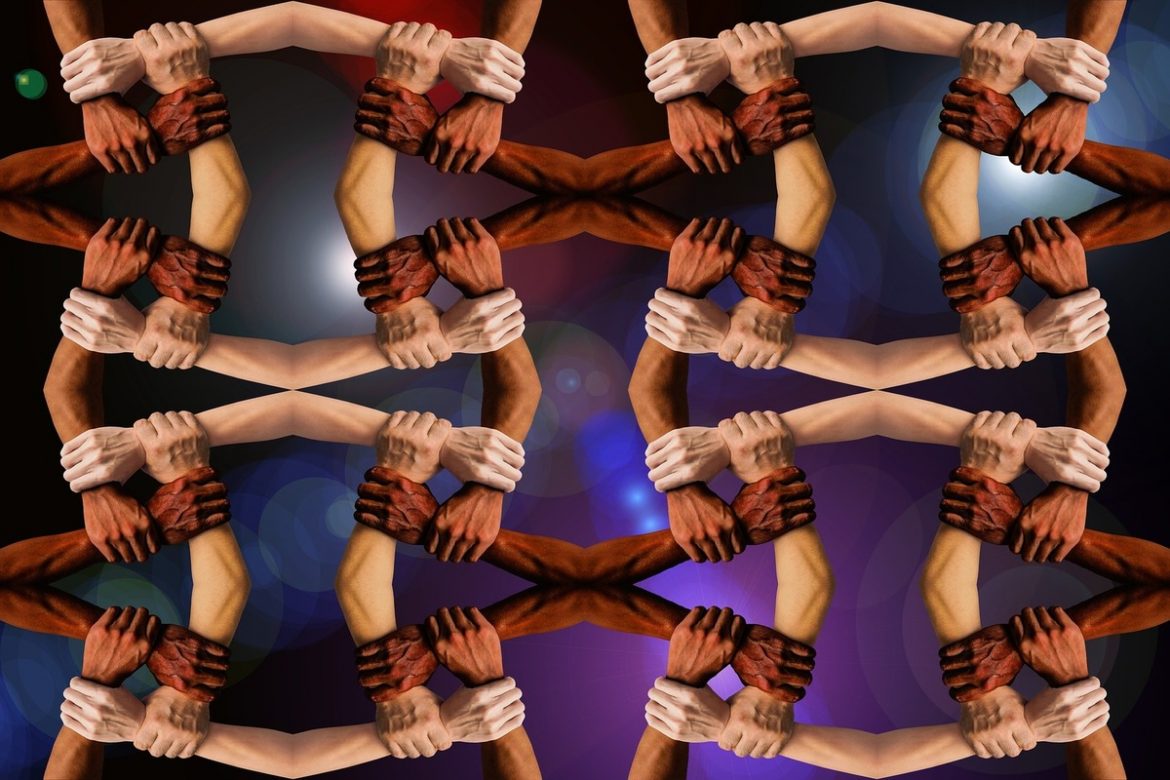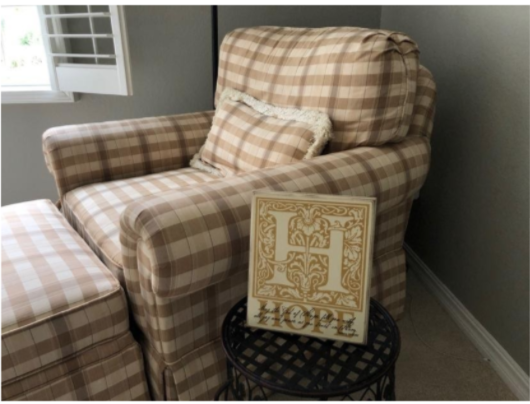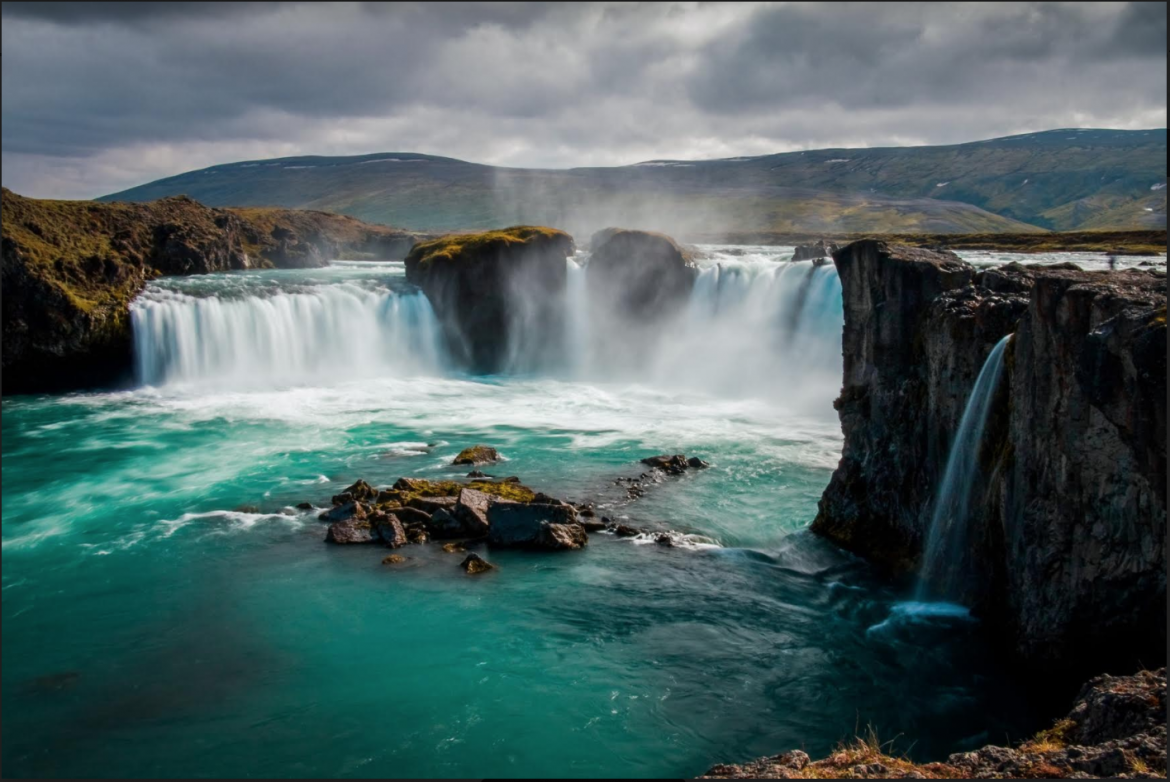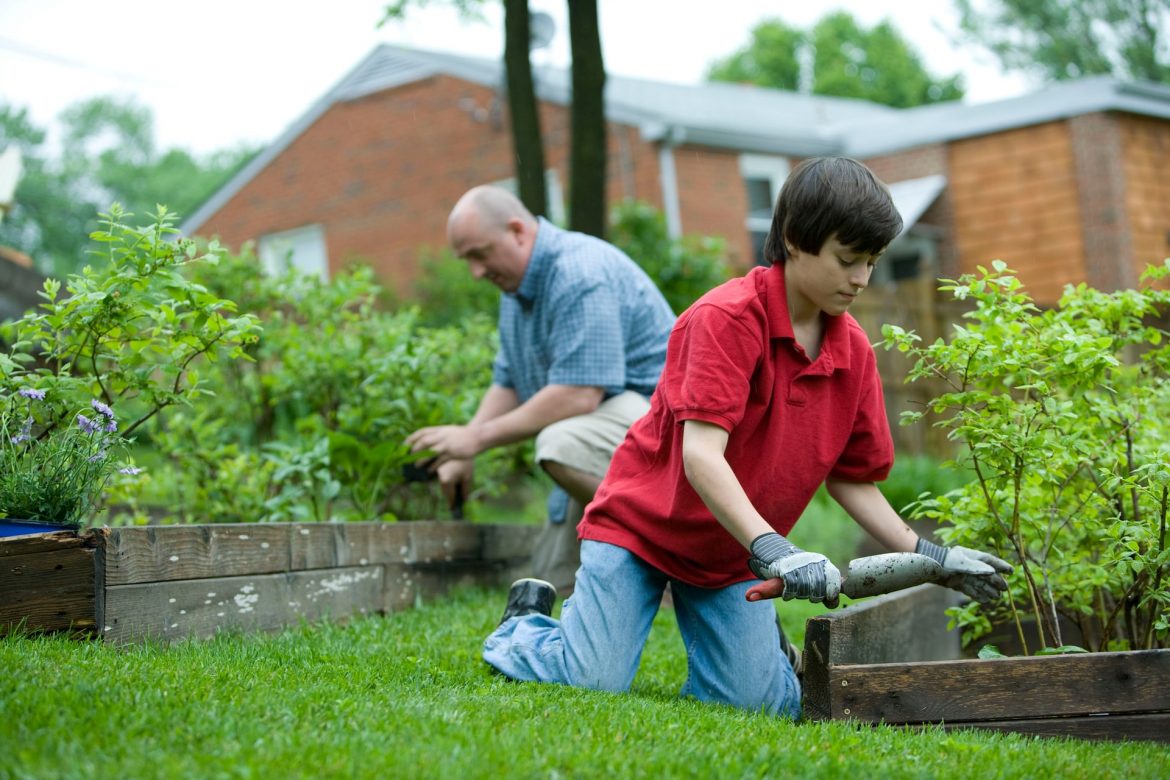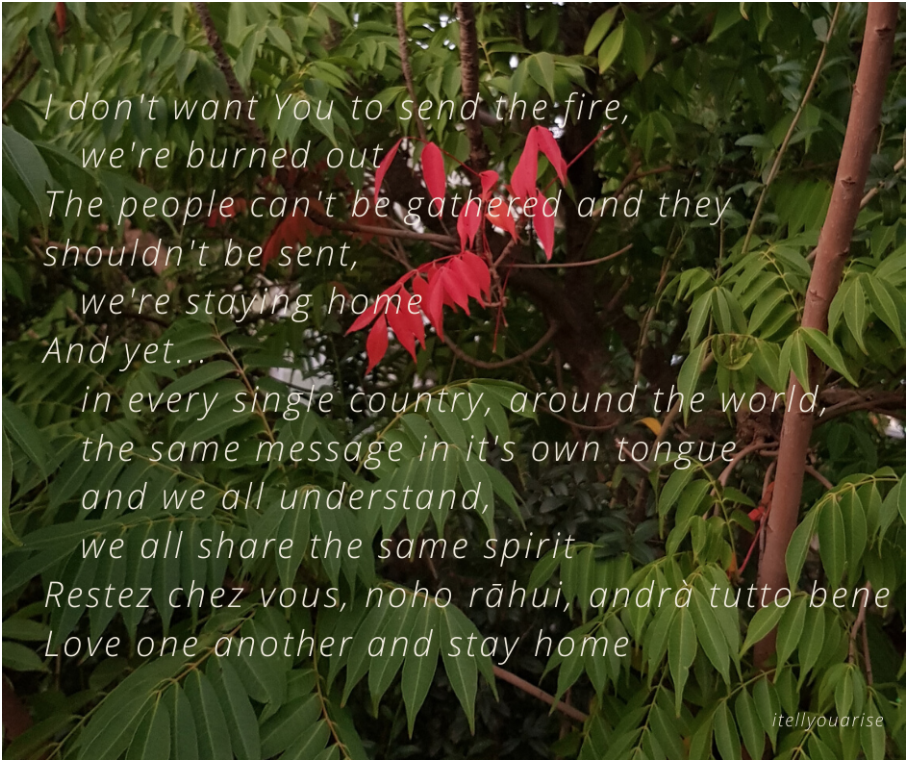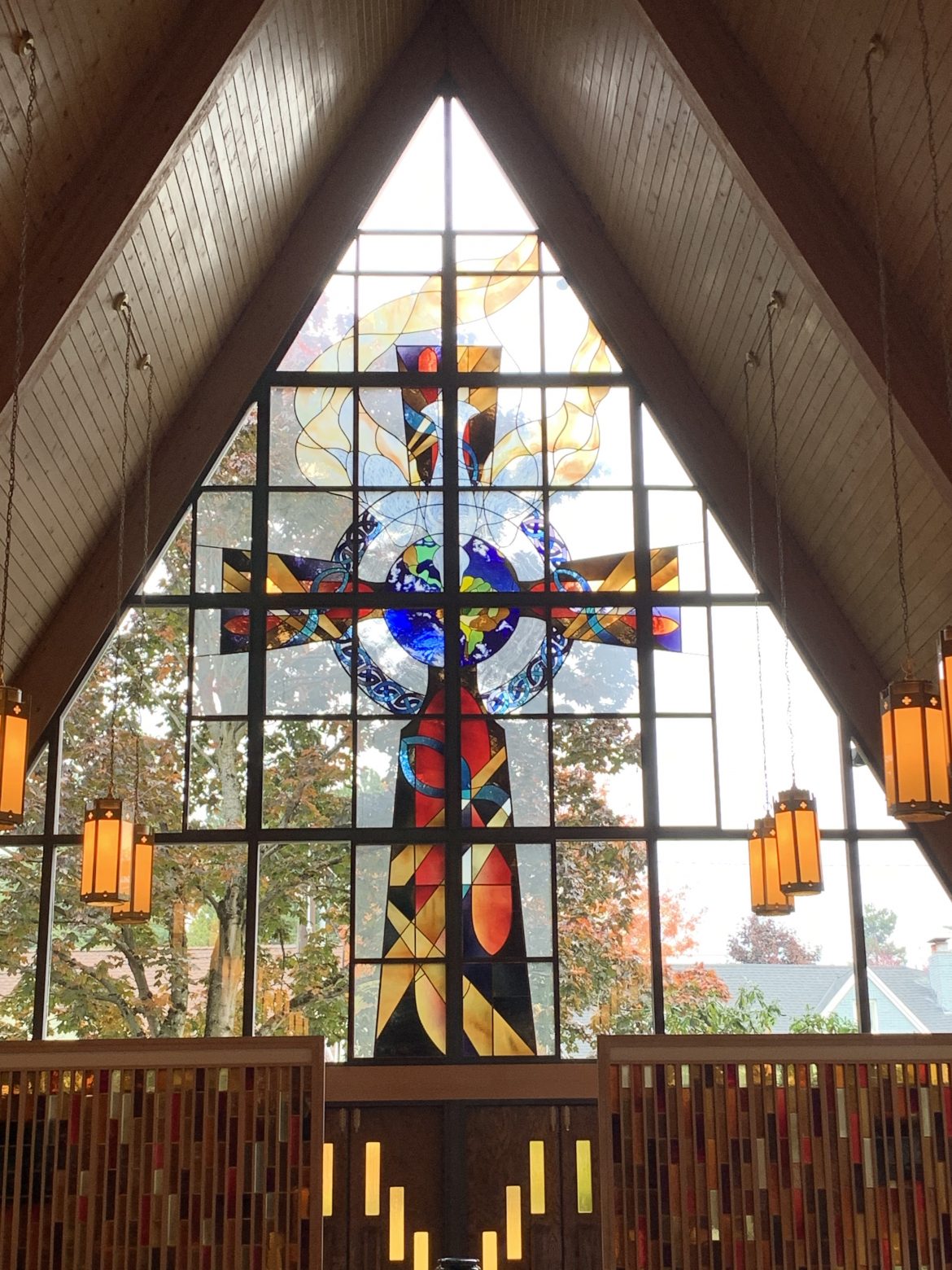 From our partners at Circlewood –
From our partners at Circlewood –
Circlewood invites us to join for a Day of Listening, Learning, and Looking. This 24 hours of prayer begins at 7pm (Pacific Standard time) tonight and continues until 7pm tomorrow.
They highlight resources that include:
- Fasting Guidelines
- Two to Watch
- Three to Read
- One to Hear
- Actions to Take
The mission of Circlewood is to cultivate transformative communities that love and care for all creation.
by Sue Duby
When friends ask me if I’m a morning or night person, I’m used to letting out a sigh with a wink and smile…”Actually, neither one! I just like to sleep!”. It must be in the gene pool. Krista and Peter both blessed me as a young Mama with 3-hour naps. I’m grateful for the gift of sleeping deep and hard most nights, though waking can be a determined choice!
These days, as I move through relaxed morning pre-coffee fog, it hits me. . . again. . . just like the movie Groundhog Day. . . and my senses sharpen realizing it’s still here. This crazy season of isolation, masks, opening up, mixed directives and missing hanging out with friends and family. Each day, I’m expectantly waiting for a gentle reminder that He’s present, in the midst and not surprised.
This morning heading for the kitchen, my eye fixed on a Mother’s Day gift from years ago. A painted frame of text, with colors that just happened to match my favorite chair. I knew I had my focus for the day.
May the God of hope fill you with all joy and peace as you trust in Him… Romans 15:13
Wow… just a bit of pondering and I could sense the challenge to embrace a shift in focus. From news, statistics and predictions that induce worry, to simple truth that produces a lighter step and smile. Back to some basics that lead to light-hearted wake-up mornings!
- God IS the God of hope. The very author and anchor of hope. The one who makes it possible for us to have “favorable and confident expectation; happy anticipation of the good” (Strong’s) even with an unseen future.
- God desires to FILL us. So somehow, though I need to listen, follow and obey, He is the one to gift that hope, joy and peace to me. I can’t muster it up on my own. I picture an empty jar (me) and God holding a pitcher of hope, ready to pour it and fill me.
- The nature of His hope (not my own created version) releases joy and peace in that filling. His hope is certain, powerful and alive.
- In the midst, I do have one task to do. All of the above happens “as you trust in Him”. An ongoing, journeying kind of task… “as you trust”. . . along the way, in each moment, with each step. Believing He is able. Knowing His desire is to “load-lift” and bring me gladness of heart, because He loves me. Choosing trust as my stance before Him, with Him.
Paul goes further to remind us that God’s not only in the business of taking care of my heart. Rather, this amazing God of Hope fills us, “so that you may overflow with hope by the power of the Holy Spirit”. Purpose in the gift, not just for myself, but for all those around me.
Picture that same pitcher filled to the brim and spilling over. The slightest bump and more comes forth. For those He brings near. In conversation. In prayer for others. As I write a note to a friend or send a text to my kids. A sprinkling, even soaking of hope, joy and peace (all His). In my trusting and believing who He is… that amazing God of Hope. He does the filling, that allows the spilling over.
What a refreshing delight to think that our lives can be “hope, joy and peace spillers” in the midst of crazy uncertainty! Lord, show us how to daily receive a fresh filling from You, the God of Hope, so that all that You are might spill over from our lives to others. With gladness of heart and gratefulness for who You are. To encourage others in their journeys, as You have in mine.
by Tom Sine
“Maintaining motivation is becoming an increasing challenge for many people slogging through life curtailed by the coronavirus pandemic”, observes Jane Brody in the New York Times.
Are you among the growing number of people who are just attempting to make it through each tough, new day? Are you among those struggling with difficult personal, family or financial pressures? Would you like to join those who are finding a new reason for being, in these daunting days, that calls us beyond ourselves?
Check out the article “How to Maintain Motivation During Dark Times”, the author introduces us to psychologist Victor Frankl. He survived an even more daunting time during the four brutal years he spent in a Jewish concentration camp with his parents and many others that did not survive.
“Doing what is meaningful- acting on what really matters to a person—is the antidote to burnout.” Frankl insisted. What in fact enabled Frankl was not focusing on the very uncertain future facing him and his parents. What enabled him to survive was to focus on the needs of others in the concentration camp and ways he could enable them to make their lives better.
When he and his parents were liberated from the German concentration camp at the end of World War II, he continued to live a very purposeful life with his parents in Austria. As a professor, Frankl wrote a very influential book titled Man’s Search for Meaning. This book was translated into a number of different languages and became an essential resources in enabling millions of readers to recover from the horror and violence of that ward but to also enable them to discover a new reason for being as people slowly began to recover from the huge disruption of that horrific war.
I encourage all of us who have chosen to be followers of Jesus to also join those that are choosing to shift their lives from the ongoing uncertainty of life to choose to live on purpose. In the Gospel of Matthew, Jesus called those first disciples, in another very disruptive time, to follow him be choosing to live a purpose-focused way of life. He challenged them and all of us as disciples today “to love God with all our heart and to love our neighbors as we love ourselves.” (Mt 22:39).
Before the Pandemic ever engulfed our troubled world, Dwight Friesen and I point out in 2020s Foresight that our churches in the United States are facing two very contenting areas of decline. In recent years, research reveals we have less daily time to be present to our God in prayer and biblical reflection. The research also reveals that Christians have less time to join those reaching out to empower their neighbors in times like these. One of the surprising impacts of the Pandemic is that even those outside of religious groups are turning to God in prayer.
I urge you, whether you are religious or not, to start every day in prayer and join those who are deeply loved by the creator God.
I would also urge you to take time every week to start reaching out to those who are worse off than you are by phone or email. I suspect it will enable you to discover, with many others, the good life of God is indeed the life given away; reaching out to others in need.
Speaking of reaching out in the neighborhoods, the Parish Collective is showing churches how to not only provide food to those in need but also how to help neighbors plant gardens and fruit trees as well…plus other community empowerment projects.
We are living in a very daunting and disruptive time in which thousands of our neighbors are not just having to contend with the disruptions but also the untimely death of family and friends. Instead of allowing ourselves to be pre-occupied with daily disruptions of the Corona Pandemic, why not join those that are choosing as followers of Jesus to live on purpose?
How about choosing every day to be present to our God in prayer and biblical reflection? How about also carving out some time every week to join those reaching out to our struggling neighbors?
We would love to hear about how you have chosen to live on purpose and the difference it makes in your life and the lives of others.
 New book by Tom Sine and Dwight Friesen called 2020s Foresight: Three Vital Practices for Thriving in a Decade of Accelerating Change will be released in September 2020 by Fortress Press.
New book by Tom Sine and Dwight Friesen called 2020s Foresight: Three Vital Practices for Thriving in a Decade of Accelerating Change will be released in September 2020 by Fortress Press.
The River of God has burst its banks
and is One with the wide-open sea.
Flowing from the sanctuary of Heaven,
into the salty sea.
All will become fresh as the morning
that rises on Galilee.
The River of God has burst its banks
and is One with the wide-open sea.
We need the peace of greening leaves
that grow for the healing of Nations,
We need the green and healing leaves
to release some divine revelations.
We need to dream with the dreams of a child
and dream without fear of delay.
We need to dream like we’re newly born
and learn once again how to play.
Not ankle or knee-deep or waist-deep,
the River runs wider and broader,
We enter with no hesitation
and give over to the flow of the water.
Not holding back from the invitation,
not rooted to the sand on the shore,
We let go of our stale disappointment
and take hands with the Lord of it all.
We remove all the things we depend on
to keep all our old stuff together.
Our stuff is now flotsam and jetsam
and it’s You we hold onto forever.
I wrote this poem on the 23 May 2020, but I want to first take you back in time a few months to 21 January 2020. We were at church and during the time of corporate worship, I had a vision of people from the valley of Ezekiel 37 dry bones, who were now resurrected back to life. People who knew what it was to feel like things in them had died were now experiencing fullness of resurrection even in areas they thought would never again see the light of day. I felt that these people would know what it is to really experience resurrection in their lives and circumstances.
Fast forward ten chapters to Ezekiel 47, and I saw this vast people at the shore of the waters. It was time for them to go so deep that they were not able to depend on their own ability anymore. It was no longer about ankle deep, knee deep or waist deep. It was about entering the fullness of surrender. And as everyone’s feet lifted off the ground, I saw all of these people carried on the currents.
On the opposite side were the trees with leaves for healing of the nations. And I saw the leaves being picked and placed in the waters which became a huge arterial river system and spread out over the whole world, a living river.
The people were drifting into the river systems and being carried by the Spirit to the places they were meant to go, both spiritually through intercession and physically as a move to other places. I saw them building with living stones and the stones were gold and alive. I couldn’t recognise what they were building, but I realised that they were building the Kingdom and it will be unconventional and unrecognisable, and yet it’s Kingdom nonetheless. It was not constrained within the four walls of a building, but living and active in the hearts of people and communities. This included people who were burned out by religion and also people who would never step through the door of a church. This Kingdom is being built for all people and it will be accessible.
The leaves are bringing the healing of resurrection to people and situations. The stories and testimonies of the ways in which God has resurrected them will bring healing and transformation.
I felt led to Ephesians, the power that raised Christ from the dead, alive and at work in each one of us. And I saw the empty cross filled with anointing oil being poured out onto the rivers spread out to all the nations to heal the cracks and dry emptiness of the world with resurrection healing. And the power of the empty cross, where Jesus is resurrected and alive, healing and forgiving the nations, renewing the face of the earth.
We are seeing a global shift the scale of which we’ve not lived through before. And yet, the God of resurrection is alive and well and has the bigger picture in mind that we are not be able to see just yet. But we are called into resurrection and a fresh baptism of the fires of Pentecost. We are breathed on with God’s breath which brings creation life back into us. Let us enter resurrection with everything that feels dead in us and see ourselves re-birthed this Pentecost. May we experience the baptism of fire and Spirit and awaken to a new sense of purpose in this awakening world.
“In my vision, the man brought me back to the entrance of the Temple. There I saw a stream flowing east from beneath the door of the Temple and passing to the right of the altar on its south side.
The man brought me outside the wall through the north gateway and led me around to the eastern entrance. There I could see the water flowing out through the south side of the east gateway.
Measuring as he went, he took me along the stream for 1,750 feet and then led me across. The water was up to my ankles. He measured off another 1,750 feet and led me across again. This time the water was up to my knees. After another 1,750 feet, it was up to my waist.
Then he measured another 1,750 feet, and the river was too deep to walk across. It was deep enough to swim in, but too deep to walk through. He asked me, “Have you been watching, son of man?”
Then he led me back along the riverbank. When I returned, I was surprised by the sight of many trees growing on both sides of the river. Then he said to me, “This river flows east through the desert into the valley of the Dead Sea. The waters of this stream will make the salty waters of the Dead Sea fresh and pure.
There will be swarms of living things wherever the water of this river flows. Fish will abound in the Dead Sea, for its waters will become fresh. Life will flourish wherever this water flows. Fishermen will stand along the shores of the Dead Sea.
All the way from En-gedi to En-eglaim, the shores will be covered with nets drying in the sun. Fish of every kind will fill the Dead Sea, just as they fill the Mediterranean. But the marshes and swamps will not be purified; they will still be salty. Fruit trees of all kinds will grow along both sides of the river. The leaves of these trees will never turn brown and fall, and there will always be fruit on their branches. There will be a new crop every month, for they are watered by the river flowing from the Temple. The fruit will be for food and the leaves for healing.”
Ezekiel 47:1-12 NLT
“I also pray that you will understand the incredible greatness of God’s power for us who believe him. This is the same mighty power that raised Christ from the dead and seated him in the place of honor at God’s right hand in the heavenly realms.”
Ephesians 1:19-20 NLT
“For he raised us from the dead along with Christ and seated us with him in the heavenly realms because we are united with Christ Jesus.”
Ephesians 2:6 NLT
Then the angel showed me the river of the water of life, bright as crystal, flowing from the throne of God and of the Lamb through the middle of the street of the city; also, on either side of the river, the tree of life with its twelve kinds of fruit, yielding its fruit each month. The leaves of the tree were for the healing of the nations.
Revelation 22:1-2 ESV
by Christine Sine
It’s time to get back to church… or is it? I know that many church leaders are struggling with when and how to begin gatherings again. Some want to do it in one fell swoop, others want to be cautious and go slow. And congregants are reacting in the same ways.
As I thought about that this week in the midst of launching The Spirituality of Gardening online course it occurred to me: Maybe rather than getting people back into church, we need to get them out into the garden instead. Here is why I think that.
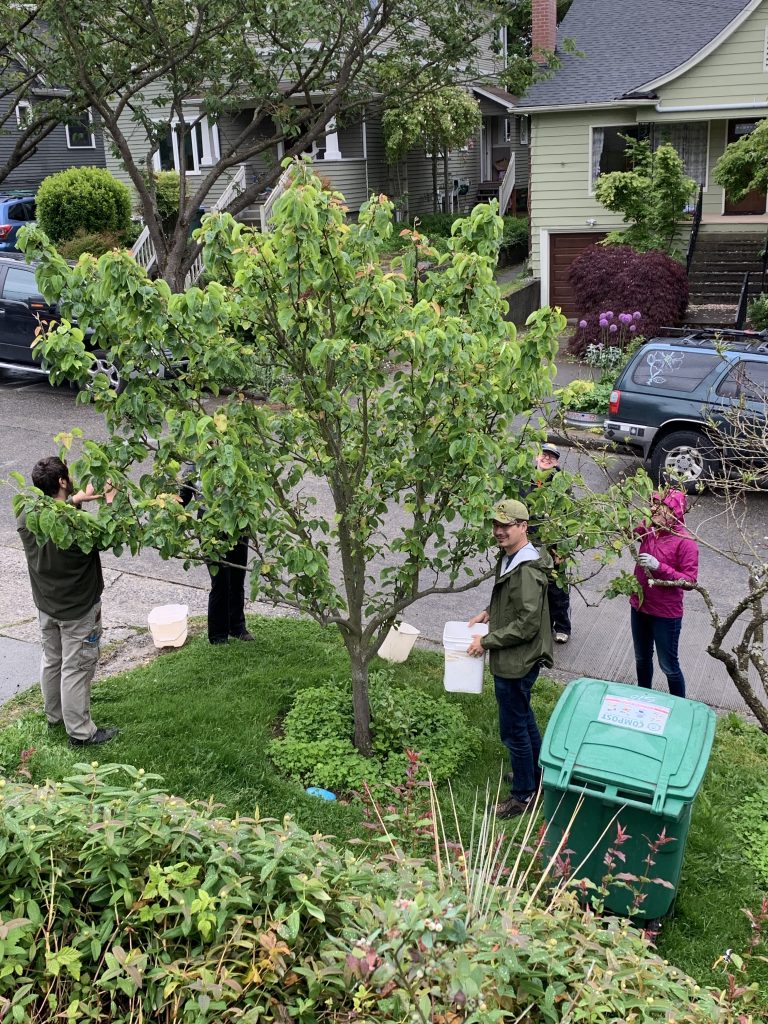
Socially distanced garden day
The garden provides the ultimate worship experience.
It stirs all the senses and touches us in that deep part of our souls where beauty, fragrance, abundance, and delight all reside. And, of course, it can provide this wonderful worship experience in an environment where we can socially distance safely (outside has less risk of spreading the virus than inside does) and yet enjoy good fellowship. I know this is true because we still do community garden days at the Mustard Seed House with good safe distancing but much pleasure in each other.
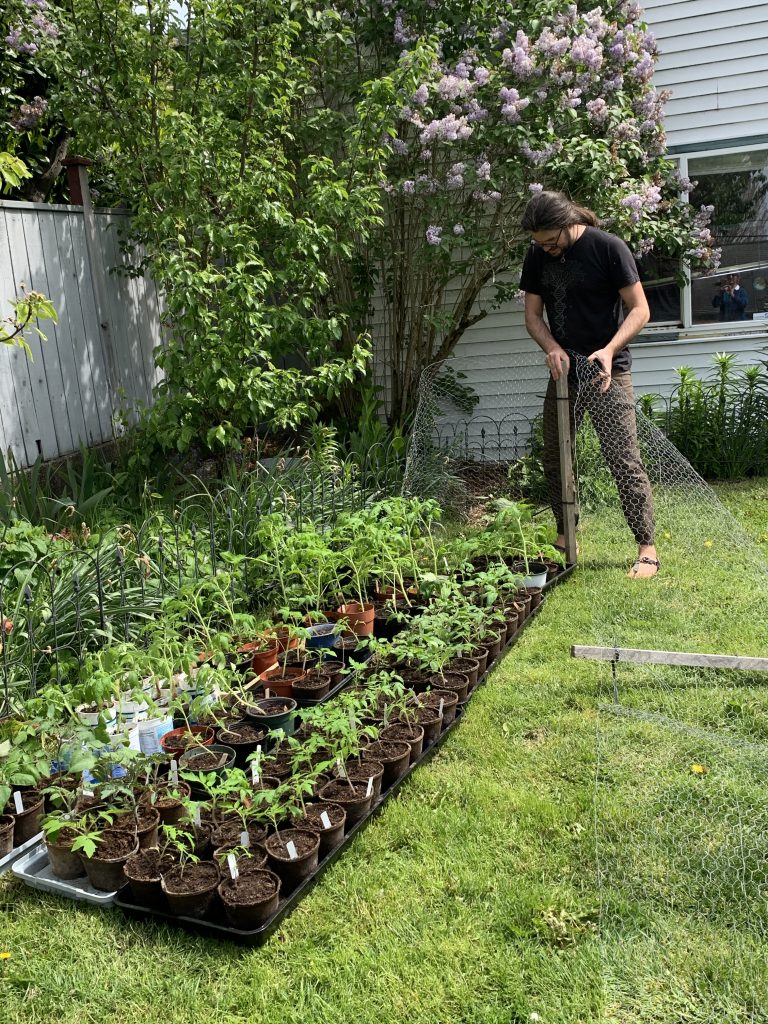
Hardening the tomato plants
The garden provide the most wonderful discipleship opportunities.
I am constantly learning from the garden as has probably been obvious to you over the last few weeks as I shared about The Gift of Strawberries and What We Can Learn From Tomatoes About Reopening Our Churches. Jesus frequently used garden metaphors in his preaching. The parable of the sower is a good example. And we don’t fully understand so much of what is said in the Bible when we lack garden connections. Like that seemingly throw away line in John 20:15 where it says of Mary “and she thought he was the gardener“. Even the compost bin has much to teach us about the ways of God.
A place where diversity is paramount
Monoculture gardens demand more fertilizer, more pesticide and more work. Diversity is a necessity if we want a healthy organic garden. I think our churches could learn a lot from that. What if we saw diversity of age, ethnicity and social strata as a necessity for a healthy church? Can you imagine how it would change our churches and our attitudes towards people? And yet God works though diversity and I think the church needs to as well.
A place where all are equal.
I love to get out in the garden with a group of people of all ages, social backgrounds and ethnic groups. This is the place where we easily fall into a camaraderie of true equality. Those at the margins are often the ones with the most knowledge. Kids love to tell their elderly friends what they have learned and all of us are in our oldest clothes so you have no idea who is poor and who is wealthy. The racism that continues to boil over here in the U.S. horrifies me and the fact that Sunday mornings have in the past been described as the most segregated time in the week is an appalling thought. We need the solidarity of community as described in Galatians 3:28, what Dorothy Butler Bass described in a recent article as “Paul’s rallying cry to overcome divisions of race, class, and gender.”
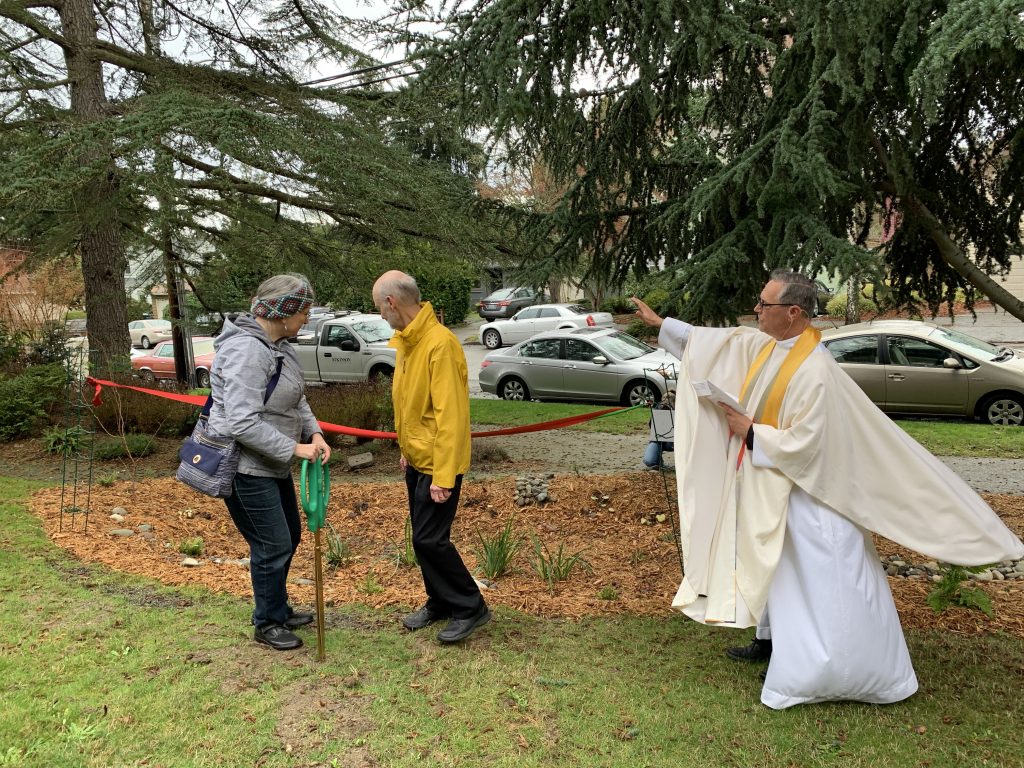
Dedicating rain garden at St Andrews
A place where we meet the true master gardener.
We so easily forget that God was the first gardener, the true master gardener who created us to be co-gardeners in Eden. Can you imagine the delight of walking in the cool of the evening with God like Adam and Eve did? Imagine the Eternal one delighting in the beautiful plants in the garden, suggesting how to prune and fertilize for best productivity, enjoying the luxuriant growth we were called to tend and look after. Here we experience the delight of reconnecting to our true vocation – something that I think that church is meant to help us do.
A place where we find sustenance for body and soul.
When I come in from the garden, or even from one of my awe and wonder walks around the neighbourhood, I feel that I glow with delight (and Tom thinks the same thing.) In The Spirituality of Gardening course, I talk about some of the benefits of gardening and the substances that help produce those ecstatic moments for us – it is fascinating. We are created to interact with gardens. Now that doesn’t mean that we all need to grow vegetables, or even plant flowers, but it does mean that we all need to get out into nature and interact with God’s wonderful creation.
So as you get ready to go back to church, consider this – how could you make space for outdoor gatherings amidst God’s creation? How would that enhance your worship and your experience of God and of each other? There are actually whole church movements that revolve around outdoor meetings – groups like Forest Church and Wild Church that I think could teach us a lot about alternative ways to gather that could keep us safe and healthy and draw us together in new and inspiring ways. What do you think?
These are significant times, and time for reflection on what we are doing with our lives or where we are going… measured somehow in sourdough starters and workout counters. I have felt resistance to that and a lack of capacity to do or be more than I am. This poem speaks to that resistance, to do and be no more than I am, but while we are still – God moves yet and Pentecost happens anyway.
I don’t want You to send the fire,
we’re burned out
The people can’t be gathered and they shouldn’t be sent,
we’re staying home
And yet…
in every single country, around the world, the same message in it’s own tongue
and we all understand, and we all share the same spirit
Restez chez vouz, noho rāhui, andrà tuto bene
Love one another and stay home
I know that many of you appreciate these Taize style services. I want to apologize to those of you who are not familiar with Taize, however, for not explaining what this term refers to. These contemplative liturgies are based on the worship of those written by the ecumenical monastic fraternity in Taizé, France. The St. Andrew’s includes singing of Taizé chant-like songs, silence, and communion. This kind of meditative liturgy helps us to breathe deeply and relax. To learn more about the Taizé service and the Taizé community, please visit their rich and informative website.
A contemplative prayer service with music in the style of Taize from St. Andrew’s Episcopal Church., Seattle, for Pentecost Sunday. Carrie Grace Littauer, prayer leader, with music by Kester Limner and Andy Myers. Permission to web stream or podcast music in this service is granted under One License number A-710-756. “Kyrie for the Pandemic,” is an original composition by Kester Limner and Andy Myers and is shared under the Creative Commons License, Attribution (CC-BY).
As an Amazon Associate, I receive a small amount for purchases made through appropriate links.
Thank you for supporting Godspace in this way.
When referencing or quoting Godspace Light, please be sure to include the Author (Christine Sine unless otherwise noted), the Title of the article or resource, the Source link where appropriate, and ©Godspacelight.com. Thank you!

